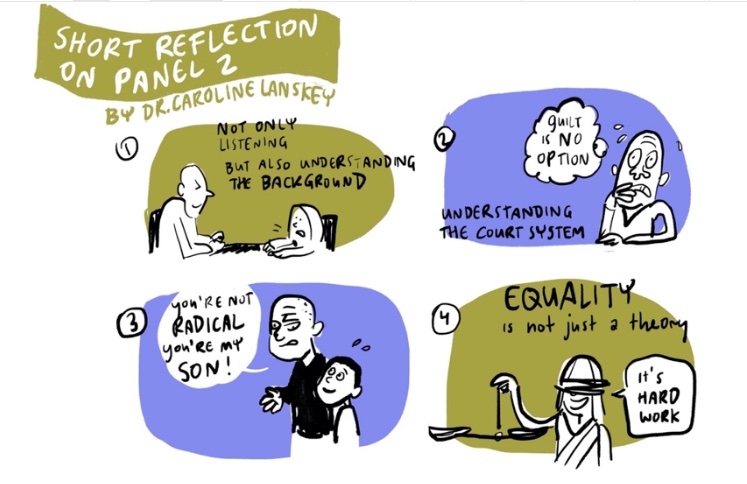Children and young adults in contact with the law: systemic vulnerabilities and ethnic, religious or cultural origin – Part 2
By Anna Pivaty, Stephanie Rap and Eva Schmidt

On 16 April 2021, Dr. Stephanie Rap (Leiden University), Dr. Anna Pivaty (Radboud University and Maastricht University) and Eva Schmidt, LL.M. (Leiden University) organised an international webinar with the title ‘Children and young adults in contact with the law: Systemic vulnerabilities and institutional responses’ sponsored by the Netherlands Network for Human Rights Research. This blog describes the ideas presented in the second panel of the webinar, which analysed vulnerabilities of children based on a different ethnic, religious or cultural origin and the corresponding responses from legal institutions.
Stephanie Rap (Leiden University) highlighted the views of professionals and refugee and migrant children in the Netherlands on the right to effective participation in asylum proceedings and how these views can be taken into account when conceptualising the right to participation for refugee and migrant children. She observed that in reality asylum interviews of children aim at gathering facts and evidence necessary to determine whether or not to grant asylum, and not at enabling children to have their voice heard, as is required by the CRC and other international instruments. She attributed this mismatch to the political nature of asylum decisions and high complexity of asylum systems.
Iris Sportel (Radboud University) presented the preliminary findings of her research into how Dutch courts take families’ ethnic, cultural or religious backgrounds into account when making decisions with respect to children in criminal, migration and family protection proceedings. She noted that across various areas of law, Dutch judges and other professionals did not explicitly address the issues of culture or ethnicity, even though they were aware of possible cultural value conflicts which could negatively impact the procedural position of the child. She ascribed this finding to the tendency of avoiding references to race or ethnicity in the Dutch society.
Nina van Capelleveen (Leiden University) discussed the various interventions that are used to tackle radicalisation of children, and how these interventions can be employed while balancing fundamental rights, child protection and public safety. The preliminary finding of her interview-based research is that often the choice of interventions does not seem to be based on applying the corresponding legal framework governing the use of the different possible measures from various areas of law. Rather, the decision is taken pragmatically based on which organisation is considered best suited to ‘reach’ the child in question.
Yannick van den Brink (Leiden University) addressed the fundamental principle of equality in the youth court and the meaning, perceptions and implications of the principle of equality in youth justice. Based on the outcomes of an interdisciplinary literature review and an extensive qualitative study of English youth courts, he presented a theoretical model, which can be used to measure equality in the particular context of youth courts.
After these presentations, Caroline Lanskey (University of Cambridge) provided a short reflection on the second panel. She addressed, among other points, the importance of achieving equality and justice in practice, or as Amartya Sen has put it: the difference between the ‘niti’ and ‘nyaya’ of justice. Researchers should be mindful of the differences between the values that criminal justice systems and institutions espouse to achieve in theory, and those that they are actually guided by in practice. She also pointed at potential ‘blind spots’ of human rights frameworks when dealing with child vulnerabilities. One example is the assumption that participation of children in legal procedures is always desirable. Another challenge is that legal systems lack the means to deal with potential conflicts of values which may affect the child’s position, such as cultural values or the values of ‘good parenting’.
Caroline observed that:
In addition to the structural vulnerabilities related to the child’s minority status in society, the papers presented in this panel engage with additional situational vulnerabilities related to children’s ethnic or cultural background and their precarious citizenship status, as well as other related vulnerabilities such as the use of language. The recognition of these differences illuminates the increased vulnerability of children at the face of the legal system not only because of the inherent power differences between children and adults, but also because of the risk of misunderstanding or misconceptions around cultural issues, or even reluctance to recognise these issues.
This webinar highlighted the importance of paying attention not only to children’s psycho-social development, but also to the network of their social relationships and interactions with the court and the justice system. As observed by Caroline Lanskey, given the traditionally individualised nature of rights, the child’s relational self might be overlooked by child rights frameworks. It is high time to address the notion of child vulnerability in the legal system as a contextual, interactional and multi-dimensional concept.
Bios:
Anna Pivaty is Assistant Professor of Criminal Law, Faculty of Law, Radboud University.

Stephanie Rap is Assistant Professor, Department of Child Law, Institute for Private Law, Leiden University.

Eva Schmidt is an LLM, PhD Researcher, Department of Child Law, Institute for Private Law, Leiden University.
